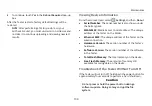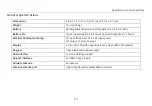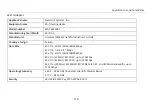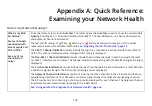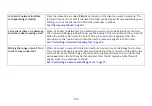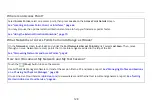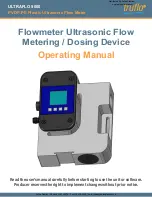
Specifications and Compliance
119
To reduce potential radio interference to other users, the
antenna type and its gain should be so chosen that the
equivalent isotropically radiated power (e.i.r.p.) is not more
than that necessary for successful communication.
Conformément à la réglementation d'Industrie Canada, le
présent émetteur radio peut fonctionner avec une antenne
d'un type et d'un gain maximal (ou inférieur) approuvé pour
l'émetteur par Industrie Canada.
Dans le but de réduire les risques de brouillage
radioélectrique à l'intention des autres utilisateurs, il faut
choisir le type d'antenne et son gain de sorte que la
puissance isotrope rayonnée équivalente (p.i.r.e.) ne dépasse
pas l'intensité nécessaire à l'établissement d'une
communication satisfaisante.
Important Note: FCC and IC Radiation
Exposure Statement
This equipment complies with FCC and IC radiation exposure
limits set forth for an uncontrolled environment. This
equipment should be installed and operated with minimum
distance 20 cm between the radiator and your body.
This transmitter must not be co-located or operating in
conjunction with any other antenna or transmitter.
Operations in the 5.15 – 5.25 GHz band are restricted to
indoor usage only.
The availability of some specific channels and/or operational
frequency bands are country dependent and not accessible
by the end user.
Exposure to RF Energy
THIS MODEL DEVICE MEETS U.S. AND INTERNATIONAL
REQUIREMENTS FOR EXPOSURE TO RADIO FREQUENCY
RADIATION.
The AirCheck G2 Tester is a radio transmitter and receiver. It
is designed and manufactured not to exceed the emission
limits for exposure to radio frequency (RF) energy set by the
Federal Communications Commission of the U.S.
Government and by the International Commission on Non-
Ionizing Radiation Protection (ICNIRP). The device also meets
the RED directive, for protecting the health and safety of the
user and other persons.
These limits are part of comprehensive guidelines that
establish permitted levels of RF energy for the general
population. The guidelines are based on standards that were
developed by independent scientific organizations through
periodic and thorough evaluation of scientific studies. The
standards include a substantial safety margin designed to
assure the safety of all persons, regardless of age and health.
Before a device model is available for sale to the public, it
must be tested and certified to operate within the limits for
safe exposure established by the FCC and international





